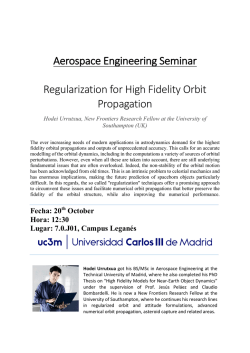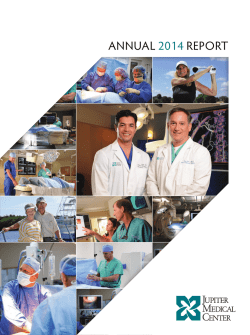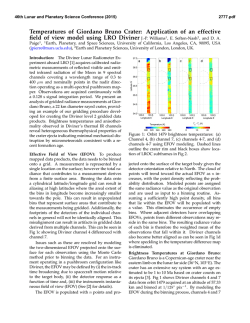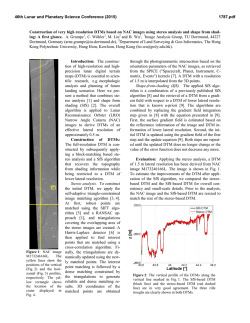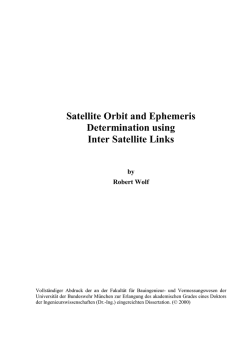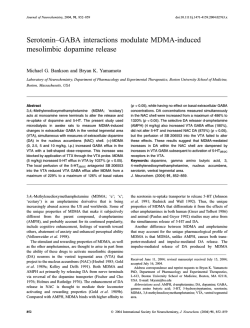
THE IO VOLCANO OBSERVER (IVO) FOR DISCOVERY 2015. A. S.
46th Lunar and Planetary Science Conference (2015) 1627.pdf THE IO VOLCANO OBSERVER (IVO) FOR DISCOVERY 2015. A. S. McEwen1, E. P. Turtle2, and the IVO team*, 1LPL, University of Arizona, Tucson, AZ USA. 2JHU/APL, Laurel, MD USA. Introduction: IVO was first proposed as a NASA Discovery mission in 2010, powered by the Advanced Sterling Radioisotope Generators (ASRGs) to provide a compact spacecraft that points and settles quickly [1]. The 2015 IVO uses advanced lightweight solar arrays and a 1-dimensional pivot to achieve similar observing flexibility during a set of fast (~18 km/s) flybys of Io. The John Hopkins University Applied Physics Lab (APL) leads mission implementation, with heritage from MESSENGER, New Horizons, and the Van Allen Probes. Io, one of four large Galilean moons of Jupiter, is the most geologically active body in the Solar System. The enormous volcanic eruptions, active tectonics, and high heat flow are like those of ancient terrestrial planets and present-day extrasolar planets. IVO uses advanced solar array technology capable of providing ample power even at Jovian distances of 5.5 AU. The hazards of Jupiter’s intense radiation environment are mitigated by a comprehensive approach (mission design, parts selection, shielding). IVO will generate spectacular visual data products for public outreach. Science Objectives: All science objectives from the Io Observer New Frontiers concept recommended in the 2011 Decadal Survey are addressed by IVO (see Table 1). Table 1: IVO Science Objectives Understand: Key Measurements A1. Io’s active volcanism High-resolution repeat imaging at UV to thermal-IR wavelengths. Measure peak lava temperature for mantle temperature and electromagnetic induction signal from mantle melt. Map/monitor global heat flow. Measure tidal Re(k2). Image and measure topography of key tectonic structures. Measure mass spectra and temporal and spatial variability of neutral species, and map spectral variations of surface. Acquire in situ and remote observations. NAC bandpasses for OI, KI, and Na-D. Distant repeat imaging to search for plumes or surface changes. Observe Jupiter, rings, moons, and magnetosphere. A2. State of Io’s interior & implications for tidal heating B1. Nature of Io’s lithosphere & unique tectonics B2. Connections between Io’s volcanism & its surface & atmosphere B3. Io’s mass loss & magnetospheric interactions B4. Limits to active volcanism on Europa C1. Jupiter system science Science Experiments: There are 5 or 6 instruments plus gravity science (see Table 2). Science measurements combine to address fundamental questions such as the internal structure and tidal heating of Io (Figure 1). Figure 1. IVO will distinguish between two basic tidal heating models, which predict different latitudinal variations in heat flux and volcanic activity. Colors indicate heating rate and temperature. Higher eruption rates lead to more advective cooling and thicker solid lids [2]. Experiment Table 2: IVO Science Experiments Narrow-Angle Camera (NAC) Wide-Angle Camera (WAC) Thermal Mapper (TMAP) Dual Fluxgate Magnetometers (DMAG) Particle Environment Package for Io (PEPI) Gravity Science Hotspot Mapper (HOTMAP) Characteristics 5 µrad/pixel, 2k × 2k CMOS detector, color imaging (filter wheel + color stripes over detector) in 12 bands from 300 to 1100 nm, framing images for movies of dynamic processes and geodesy. 25° FOV for stereo; identical electronics and detector to NAC, stripe filters but no filter wheel. 640 x 480 detector array and eight spectral bandpass stripes (5-40 μm), 125 µrad/pixel, for thermal mapping and silicate compositions. Mounted on end and middle of 3.8-m boom, low-noise sensors, range/sensitivity: 4000/0.01 nT (fine), 65,000/0.02 nT (coarse), sampling rate 8 or 60 vectors/s. Ion and Neutral Mass Spectrometer (INMS) mass range 1–1000 amu/q, with M/∆M = 1100. Plasma Ion Analyzer (PIA) mass range 1–70 amu, 0.1 to 15 keV, ∆E/E = 0.07. 2-way Doppler tracking on I0 and I2, near Io orbital periapse and apoapse, to constrain mantle rigidity. Optional Student Collaboration instrument, 25° FOV, bandpass from 1.5-2.5 microns. Instrument Mounting and Operations: The NAC and TMAP are on a ± 90° pivot for off-nadir targeting during encounters and for distant monitoring. The DMAG sensors are on the end and middle of 3.8-m boom and collect data continuously. WAC and HOTMAP are mounted on the S/C nadir deck, and observe during ±20 minutes of each Io closest approach, except I0 and I2. PEPI is mounted on the S/C structure with the INMS field of view in the ram direction when the S/C nadir deck points at Io, and the PIA 46th Lunar and Planetary Science Conference (2015) and has a large (hemispheric) field of view that will often include the upstream direction. Gravity science requires pointing the high-gain antenna at Earth during the I0 and I2 encounters. Mission Plan: IVO launches in 2021 and arrives at Jupiter in early 2026. A close Io flyby (I0) ~1.5 hrs. after Jupiter orbit insertion lowers the orbit period, followed by 8 additional encounters achieving the suite of science objectives. The highly elliptical orbit with perijove near Io is inclined >40° to Jupiter’s orbital plane (Figure 2), which minimizes total ionizing radiation dose compared to other Jupiter orbiters (Figure 3). The apoapse period of each orbit provides extended monitoring of Io and Europa at high phase angles (>120°), best to detect and monitor volcanic plumes as well as high-temperature hot spots on Io. Four of the encounters are designed for optimal measurement of induced magnetic signature from mantle melt. IVO will collect at least 20 Gb of science data per encounter: 100 times the Io data from the 8-year Galileo tour. Encounters last ~1 week, including global monitoring and four Io eclipses, with distant monitoring and data playback near apojove. I8 includes a flythrough of Pele’s plume, if it is active, for gas composition. Figure 2: IVO nominal mission orbits in 2026-27. 1627.pdf Typical Science Data Yield from One Orbit: • Imaging of full illuminated hemisphere at 500 m/pixel and key features at 5–300 m/pixel in >6 and 1–4 colors, respectively, plus pole-to-pole WAC stereo color mapping strip and HOTMAP frames. • Imaging of high-temperature activity on nightside in 2+ colors at <100 m/pixel to measure liquid lava temperatures. • Near-global TMAP coverage at 0.1–20 km/pixel to map heat flow and monitor volcanism. • Visible and thermal movies of active plumes and lava lakes. • Imaging four eclipses per encounter for hotspots and auroral emissions. • Continuous DMAG and PIA measurements with high data rate near Io. • INMS data (~200 spectra) near Io closest approach (C/A) and segments away from Io. • Distant monitoring of Io, Europa, and Jupiter system. Science Enhancement Options: A close flyby of a main-belt asteroid can be achieved during cruise to Jupiter, providing unique science and a “dress rehearsal” for Io flybys. The addition of ~20 Participating Scientists is proposed, along with support for Earthbased telescopic monitoring of Io. With a radiation design margin of 2, an extended mission could double the number of Io encounters (prior to workarounds for TID-related problems such as those by Galileo during its late extended missions). By pumping the orbit out to a longer period, it should be possible to extend the tour by 6 years, sufficient to swap sides of Io in sunlight and in darkness compared to the nominal mission, and provide extended time to monitor Jupiter. The longer period could also enable a close flyby of an outer moon, likely a captured Kuiper Belt Object [3]. References: [1] McEwen, A.S. et al. (2014) Acta Astron. 93, 539. [2] Kirchoff, M. R., and W. B. McKinnon (2009) Icarus 201:598. [3] Jewitt, D. et al. (2004) In: Jupiter. F. Bagenal et al., eds., Cambridge University Press, Cambridge, U.K., 263. Figure 3. Normalized Total Ionizing Dose (TID) of Jupiter orbiters and Radiation Belt Storm Probes (Van Allen Probes), all with radiation design margin of 2x except Galileo (actual estimate). *IVO team: F. Bagenal, S. Bailey, S. Barabash, J. Boldt, D. Breuer, A. Davies, I. de Pater, K.-H. Glassmeier, C. Hamilton, J. Helbert, R. Heyd, D. Heyner, K. Hibbard, S. Hörst , D. Humm, L. Iess, X. Jia, L. Kestay, K. Khurana, R. Kirk, R. Lorenz, J. Moses, O. Mousis, F. Nimmo, S. Osterman, C. Paranicas, C. Parker, J. Perry, E. Reynolds, A. Showman, B. Spence, J. Spencer, T. Spohn, S. Sutton, N. Thomas, M. Wieser, P. Wurz.
© Copyright 2026


